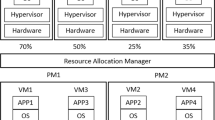Abstract
Cloud-based computing, in spite of its enormous benefits has ill effects on the environment also. The release of greenhouse gases and energy consumed by cloud data centers is the most important issue that needs serious attention. Virtual machine (VM) consolidation is a prominent method for energy efficient and optimal utilization of resources. However, existing VM consolidation approaches aggressively reduce energy consumption without considering quality of service (QoS) factors. In this paper, QoS-aware VM consolidation framework is presented which reduces energy consumption and tries to minimize Service Level Agreement violations at the same time. Unlike existing solutions, the framework is generic as it works for both CPU and input/output intensive tasks. The effectiveness of proposed framework is illustrated by using real dataset of Planet lab and CloudSim platform. The proposed solution can be used in cloud data centers to enable energy efficient computing.








Similar content being viewed by others
References
Buyya, R., Toosi, A. N., & Calheiros, R. N. (2014). Interconnected cloud computing environments: Challenges, taxonomy, and survey. ACM Computing Surveys,47, 1–47.
Buyya, R. (2009). Market-oriented cloud computing: Vision, hype, and reality of delivering computing as the 5th utility. In 9th IEEE/ACM international symposium on cluster computing and the grid.
Shehabi, A., & et al. (2016) United States data center energy usage report | Energy Technologies Area.
Adams, W. (2018). Power consumption in data centers is a global problem.
Cao, Z., & Dong, S. (2012). Dynamic VM consolidation for energy-aware and SLA violation reduction in cloud computing. In Parallel and distributed computing, applications and technologies, PDCAT proceedings.
Cao, Z., & Dong, S. (2014). An energy-aware heuristic framework for virtual machine consolidation in Cloud computing. The Journal of Supercomputing,69, 429–451.
Alboaneen, D. A., Pranggono, B., & Tianfield, H. (2014). Energy-aware virtual machine consolidation for cloud data centers. In Proceedings of IEEE/ACM 7th international conference on utility and cloud computing.
Zeng, H., Ellis, C. S., Lebeck, A. R., & Vahdat, A. (2002). ECOSystem. ACM SIGOPS Operating Systems Review,36, 123.
Chase, J. S., Anderson, D. C., Thakar, P. N., Vahdat, A. M., & Doyle, R. P. (2001). Managing energy and server resources in hosting centers. In Proceedings of 18th ACM symposium on operating systems principles.
Nathuji, R., & Schwan, K. (2007). Virtual power: Coordinated power management in virtualized enterprise systems. In Proceedings of 21st ACM SIGOPS symposium on operating systems principles.
Beloglazov, A., & Buyya, R. (2010). Energy efficient resource management in virtualized cloud data centers. In 10th IEEE/ACM international conference on cluster, cloud and grid computing.
Beloglazov, A., Abawajy, J., & Buyya, R. (2012). Energy-aware resource allocation heuristics for efficient management of data centers for cloud computing. Future Generation Computing Systems,28, 755–768.
Beloglazov, A., & Buyya, R. (2012). Optimal online deterministic algorithms and adaptive heuristics for energy and performance efficient dynamic consolidation of virtual machines in cloud data centers. Concurrency and Computation: Practice and Experience,24, 1397–1420.
Zhou, Z., Hu, Z. G., Song, T., & Yu, J. Y. (2015). A novel virtual machine deployment algorithm with energy efficiency in cloud computing. Journal of Central South University,22, 974–983.
Zhou, Z., Hu, Z., & Li, K. (2016). Virtual machine placement algorithm for both energy-awareness and SLA violation reduction in cloud data centers. Scientific Programming. https://doi.org/10.1155/2016/5612039.
Castro, P. H. P., Barreto, V. L., Corrêa, S. L., Granville, L. Z., & Cardoso, K. V. (2016). A joint CPU-RAM energy efficient and SLA-compliant approach for cloud data centers. Computer Networks,94, 1–13.
Zhou, Z., et al. (2018). Minimizing SLA violation and power consumption in Cloud data centers using adaptive energy-aware algorithms. Future Generation Computing Systems,86, 836–850.
Goyal, S., Bawa, S., & Singh, B. (2016). Energy optimised resource scheduling algorithm for private cloud computing. International Journal of Ad Hoc and Ubiquitous Computing,23, 115.
Kim, H. S., Shin, D. I., Yu, Y. J., Eom, H., & Yeom, H. Y. (2012). Systematic approach of using power save mode for cloud data processing services. International Journal of Ad Hoc and Ubiquitous Computing,10, 63.
Zhao, J., Tao, J., & Frlinger, K. (2014). A framework for comparative performance study on virtualised machines. International Journal of Ad Hoc and Ubiquitous Computing,17, 82–99.
Xu, H., Liu, Y., Wei, W., & Xue, Y. (2019). Migration cost and energy-aware virtual machine consolidation under cloud environments considering remaining runtime. International Journal of Parallel Programming,47, 481–501.
Ramezani, F., Lu, J., & Hussain, F. K. (2014). Task-based system load balancing in cloud computing using particle swarm optimization. International Journal of Parallel Programming,42, 739–754.
Mann, Z. A., & Szabo, M. (2017). Which is the best algorithm for virtual machine placement optimization. Concurrency and Computation: Practice and Experience,29(10), e4083.
Author information
Authors and Affiliations
Corresponding author
Ethics declarations
Conflict of interest
The authors declare that they have no conflict of interest.
Additional information
Publisher's Note
Springer Nature remains neutral with regard to jurisdictional claims in published maps and institutional affiliations.
Rights and permissions
About this article
Cite this article
Khattar, N., Singh, J. & Sidhu, J. An Energy Efficient and Adaptive Threshold VM Consolidation Framework for Cloud Environment. Wireless Pers Commun 113, 349–367 (2020). https://doi.org/10.1007/s11277-020-07204-6
Published:
Issue Date:
DOI: https://doi.org/10.1007/s11277-020-07204-6




